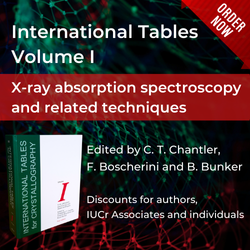
Feature article
Linus Pauling, Robert Corey, Richard Marsh, and other Caltech Crystallographers: a 1999 Conversation with Richard E. Marsh
![thumbnail [thumbnail]](https://www.iucr.org/__data/assets/image/0020/160067/thumbnail.jpg)
In May 1999, I was visiting the California Institute of Technology (Caltech), and on that occasion, I recorded a conversation with Richard E. Marsh (1922‒2017). It was during the decade when I was interviewing famous scientists. Many of my interviews appeared in The Chemical Intelligencer, a short-lived magazine about the culture of chemistry, and in the six-volume Candid Science interviews collection [1]. The project, in the meantime, had expanded into a family hobby. Some of the conversations have never been published, including the one with Marsh. Recently, I reread the Marsh conversation, recorded 25 years ago, and found it fascinating. Before I decided to submit it for consideration to Mike Glazer, the Editor of the IUCr Newsletter, I looked up two Marsh obituaries [2, 3] to avoid too much overlap. I liked both obituaries and felt that my conversation with Marsh would complement them nicely. Bernard Santarsiero's obituary [2] is especially valuable for giving an account of Marsh's major interests in crystallography, among other features of his life and activities. The collective obituary published by the American Crystallographic Association (ACA) compiled personal reminiscences by some of the chemistry and crystallographic community who knew him. I would be curious how members of the present generation of crystallographers, a whole new generation since the conversation, feel about the sad conclusion of Marsh's nostalgic reminiscences.
Marsh speaks in the conversation reproduced below. As my practice with such conversations was, I recorded it, transcribed it, and then sent it to the interviewee for checking. Our recording took place on May 18, 1999, and we finalized the text by correspondence in April 2000. First, a few pieces of information. He was born in Jackson, Michigan, studied chemistry at Caltech between 1939 and 1943, and earned a bachelor's degree. He served in the US Navy during the war and was discharged in 1946. He obtained his PhD at UCLA in 1950; his research was on crystallography of organo-selenium compounds under James McCullough's mentorship. Marsh returned to Caltech following graduation and stayed there for his entire career. This is much touched upon in our conversation. He served as President of the ACA in 1993 and was a co-editor of the IUCr journal Acta Crystallographica for 1963−1971 and 1994−2004. In 2004, he was the first recipient of the Kenneth N. Trueblood Award from the ACA.
![[1Marsh]](https://www.iucr.org/__data/assets/image/0003/160068/1Marsh.JPG) Richard E. Marsh on May 18, 1999, in his office at Caltech, by Istvan Hargittai.
Richard E. Marsh on May 18, 1999, in his office at Caltech, by Istvan Hargittai.
First, I asked him about his background, and gradually, we shifted to his famous mentors.
My father worked in a bank and edited a small business periodical. When I was about four years old, he became a full-time short-story writer, mostly Western adventure fiction, which he could work at in Jackson during the summer and in California during the winter. I had most of my schooling in Redlands, California; I spent my last two years of high school at an Episcopalian boarding school in Connecticut. By then, my father was a speechwriter and adviser for Franklin D. Roosevelt in Washington. I have an older sister, and my mother was a typical housewife of the time. My undergraduate work was at the California Institute of Technology from 1939 until 1943. I graduated with a BS in Applied Chemistry and immediately started work for the Navy, first as a civilian physicist and, later, as a service member. When I was discharged in New Orleans in 1946, I went to graduate school at Tulane University for one year, after which I married Helen Laterriere and transferred to UCLA. I received my PhD in 1950 and was hired as a Research Fellow at Caltech; I have been here ever since.
When I originally entered Caltech as an undergraduate, I had every intention of majoring in physics. However, I had always been afraid of electricity, dating, I am sure, back to a time when I was very small. I still remember the incident clearly: I stuck a piece of tin foil, with which my sister and I were playing hide-and-seek, into an electric outlet. So, when I found out that most physicists, in those days, were involved with electrical items of one kind or another, I opted for "Applied Chemistry" ‒ not because I particularly liked chemistry, but because there were not many required courses in that option. I took the bare minimum of courses in chemistry (chemistry also scared me a bit after I exploded a flask during a laboratory experiment and ended up in the hospital), but I took a lot of extra courses in things such as geology, mechanical engineering and surveying. I particularly disliked physical chemistry. My memory of that class is that it was at 8 a.m. when the professor would walk into the classroom and start writing down partial derivatives. Typically, at about 8:10 a.m., he would lose track of a minus sign; he would then search for it, with only occasional success, for the rest of the hour. After that start to the day, classes in other areas were enjoyable.
When I was discharged from the Navy in 1946, in New Orleans, I had no idea as to what to do next. Tulane University was in New Orleans, as was my fiancé, and the GI bill would pay for more education, so I enrolled there. Since I was late in registering, my class options were limited. One of those available was in X-ray crystallography (of which I had never heard), given by Rose C. L. Mooney1 at Sophie Newcomb College ‒ the female affiliate of all-male Tulane. Mooney had already created somewhat of a sensation at Caltech: she had been accepted there as a graduate student because, as "R. C. L. Mooney", she was assumed to be a male. When Caltech found out otherwise, she quickly became a "Research Assistant" for Linus Pauling instead of a graduate student. She later returned to the University of Chicago for her PhD, I believe. Eventually, she married the physicist John Slater. I found X-ray crystallography quite fascinating, but since Tulane offered little beyond a master's program, I transferred to UCLA (after having been rejected by Caltech) and signed on to do research with James D. McCullough. (His graduate work had been with Pauling at Caltech. One of McCullough's projects as a graduate student was an attempt to reproduce "Allison's Wonderland" ‒ the magneto-optic effect which Samuel Allison2 used to purportedly discover new elements such as "Alabamine" and "Illinium". McCullough was unsuccessful, as were others as well; the magneto-optic effect was discredited, and the elements were renamed.)
I received my PhD in 1950, with a thesis describing the crystal structures of a couple of organo-selenium compounds. I was then offered a post-doc position at Caltech to work in Pauling's group, and I snatched it up without further thought. Great good luck! One of the first projects I worked on at Caltech was on the structure of chlorine hydrate. The gas hydrates are clathrate compounds in which small molecules ‒ such as simple hydrocarbons, halogens, or even inert gases ‒ are trapped within polyhedra of water molecules; typically, they form stable crystals with melting points significantly above the melting point of ice. Pauling was particularly fascinated with these compounds and developed (and later abandoned) a theory of anesthesia based on them. I also worked on a number of intermetallic compounds under Pauling's general guidance, but under the more specific guidance of a slightly older post-doc, David P. Shoemaker. At the time (1950), Pauling's interests were still very diverse, covering all fields of structural chemistry. While he was concentrating more and more on biological problems, he was still trying to improve his theories on metallic bonding (and on many other structural concepts as well). Perhaps the most interesting compound I worked on was NaPb – a definite 1:1 compound in which the Pb atoms form regular tetrahedra with relatively short (about 3.15 Angstroms) and presumably covalent Pb‒Pb bonds. The Ethyl Corporation sponsored this work, but I'm not sure if anyone ever figured out any useful relationship between these tetrahedra and the tetrahedral arrangement of ethyl groups in tetraethyl lead.
In about 1953, I began to work with Bob Corey on Pauling's large project on biological structures. These were exciting times. Pauling had just published his ideas for the structures of polypeptide chains (the extended chains that form the "pleated sheets" and the more compact helical arrangements, including the alpha helix). He was attempting to convince the scientific world that the basic concepts on which they were based ‒ planar peptide groups, with the conformation of the polypeptide chain determined by N−H - - O hydrogen bonds between peptide groups ‒ were correct. One of my major projects was a study of the structure of silk fibroin ‒ a well-ordered fibrous protein, which we eventually showed to have a structure based on the anti-parallel chain pleated-sheet arrangement derived by Pauling. Another post-doc, Yuen Leung, and I also worked for several years (from about 1953 until 1957) on the structure of a single molecule, the tripeptide L-leucyl-L-prolylglycine, before we were successful. During this project we progressed through many of the early stages of computer advancement. This was from punched-card IBM tabulating machines, through a primitive "calculate and punch" machine and a rotating-drum storage computer and ending on a "Datatron" computer. This had sufficient power that we could carry out a least-squares calculation during a single 8-hour overnight operation (maybe a 2-second event on a modern PC).
In describing the structures that he was proposing, Pauling made extensive use of space-filling atomic models, originally machined from wood and, later, molded from hard rubber plastic; these eventually evolved into the very popular "CPK" (Corey, Pauling, Koltun) models. He also made use of more esoteric models. In particular, I remember a "fish helix" ‒ an array of blue plastic fish glued together head-to-tail so as to form a regular spiral. The point of this model was to demonstrate that a helical array did not need to have an integral number of amino acid residues per turn (such as 2, as in the pleated-sheet structure) in order to form a repetitive structure ‒ the alpha helix ‒ which could give rise to a characteristic diffraction pattern.
In these early 1950s, the majority of work in the Chemistry Department at Caltech was carried out with financial support raised by Pauling and on projects of interest to him. (This may be why he didn't receive wholehearted support from the entire faculty later on when his peace efforts led to friction with Caltech's Board of Trustees and his decision to leave.) The number of eminent scientists who spent significant time working in Pauling's group at about that time was large. Without attempting to search any records, I come up with names such as Otto Bastiansen, David Davies, Jerry Donohue, Jack Dunitz, Walter Hamilton, Ken Hedberg, Edgar Heilbronner, Karst Hoogsteen, Jim Ibers, Harvey Itano, Joe Kraut, Chia-Su Li, Bill Lipscomb, Matt Meselson, Alex Rich, Massimo Simonetta, Ken Trueblood and You-Chi Tang, among those who went on to eminent careers in countries all over the world.
Those on the Caltech faculty who worked most closely with Pauling included Verner Schomaker (primarily in electron diffraction, but of tremendous help to everyone because of his great knowledge of physical and structural chemistry), Bob Corey (who managed and gave close personal attention to the structural biology projects), Holmes Sturdivant (who developed and maintained most of the diffraction equipment, as well as managed the departmental finances), Eddie Hughes (the most knowledgeable in the general area of X-ray diffraction) and Dan Campbell, who specialized in immunochemistry and was responsible for much of the work on hemoglobin and sickle cells.
I was not actively involved in Pauling's attempt to derive the structure of DNA. The diffraction data that he had available (much of it obtained, with difficulty, by Alex Rich) were of poor quality and suggested little more than, probably, a helical structure. Pauling's attempts to derive this helix were based primarily on model building, often with pieces of aluminum ‒ large flat ones to represent the bases, small tetrahedral ones to represent the sugar atoms; the bonds between them were aluminum rods fitted into drilled holes with set screws. As we all know, the structure that he and Corey eventually settled upon was based on a triple-strand helix held together by hydrogen bonding between phosphate groups on the inside of the helix. I remember they were not entirely satisfied with this model. (Verner Schomaker, for one, was skeptical of it because of the distortions from conventional bond angles that were introduced to improve the hydrogen bonding and to relieve crowding.) The paper that Pauling and Corey eventually submitted [4] reflects their lack of confidence: "...the structure cannot be considered to have been proved to be correct ... the best solution of this problem that we have found."
While I am sure that Pauling and Corey were disappointed when their proposed structure was shown to be incorrect, I know they took pride in learning that one of their students ‒ Jerry Donohue ‒ was helpful in steering Watson and Crick toward the correct structure. And I don't recall any bitterness toward Watson and Crick; indeed, they both visited Caltech and seemed to be on friendly terms with Pauling. (I am of the opinion that it was Jim Watson, or an editor of his book, who was primarily responsible for the concept of a bitter rivalry.)
This was at the time that Pauling was becoming active in the peace movement and was under close scrutiny by the McCarthy committee; he had many other things on his mind. But it is also my memory that many of us at Caltech remained skeptical of the Watson‒Crick structure for a number of years, perhaps because of jealousy but also because a detailed interpretation of Rosalind Franklin's photographs in terms of the proposed structure was not available. Accordingly, considerable efforts were made to obtain crystals of various combinations of base pairs, and there was some joy when Karst Hoogsteen, in 1959, showed that crystals of a 1:1 complex between 1-methylthymine and 9-methyladenine showed a "reverse" base pairing, different from that proposed by Watson and Crick. On the whole, though, I never felt that Pauling was as interested in the DNA problem as he was in proteins.
![[2Marsh]](https://www.iucr.org/__data/assets/image/0004/160069/2Marsh.jpg) Richard E. Marsh and Linus Pauling sometime in July 1960 at the California Institute of Technology. Photograph by Ned Webb, one of Marsh's graduate students, and courtesy of Richard Marsh (colorized).
Richard E. Marsh and Linus Pauling sometime in July 1960 at the California Institute of Technology. Photograph by Ned Webb, one of Marsh's graduate students, and courtesy of Richard Marsh (colorized).
The relationship between Pauling and Corey was quite close scientifically, even though they were distinct opposites in personality. Pauling had wonderful chemical knowledge, instincts and intuition and was not reluctant to come to firm conclusions from a minimum of data. Corey was the exact opposite, always wanting to be absolutely certain. Pauling could construct a logical and coherent manuscript during a single dictation; Corey would fuss with every word in that manuscript, and probably add several caveats, before putting his name on it. If Pauling was frustrated by Corey's nitpicking, I don't believe he ever showed it; indeed, I believe that Pauling fully understood his own impetuosity and realized the need to restrain it ‒ in scientific publications, at least. Corey never entered Pauling's world of peace marches and colorful interviews and would have been very uncomfortable in it. Nor did the Paulings and the Coreys interact socially, their wives being just as opposite in personality and interests as the husbands. There has been considerable speculation that Ava Helen Pauling was the driving force behind her husband's peace and anti-nuclear efforts; Dorothy Corey almost never appeared in public. Although Pauling called Corey "Bob", I don't remember hearing Corey say anything other than "Dr Pauling". They both were warm in their relations with others; I remember no time when either of them expressed displeasure in the actions of any of their associates. Pauling, in fact, may have had almost too much empathy for other people and not enough ability to say "no". My impression was that he would meet somebody ‒ perhaps a foreign scientist, perhaps an undergraduate student, perhaps a friend of a friend ‒ who would remark that he would very much like to work in Pauling's lab. Acceptance might be immediate, after which Holmes Sturdivant would have to find the salary, and Bob Corey would have to find the space. During the late 1950s there seemed to be a continual flux of assorted people working on a variety of projects, not all of which seemed to make good sense. But there were also lots of people doing quite wonderful things in many areas of structural chemistry and biology. It was an exciting time.
As Pauling's involvement in the peace movement became stronger, his relations with Caltech ‒ and, particularly, with Caltech's rather conservative Board of Trustees ‒ became more strained; in addition, the Chemistry Department was growing larger and more diverse. In 1958, Ernest Swift succeeded him as Department Chairman, and in 1964, Pauling officially left Caltech (retaining an honorary appointment as a Research Associate). Since I was not in the professorial chain at Caltech, I was not privy to the details of Pauling's departure. I suspect there were some hard feelings on both sides ‒ on Pauling's part, a belief that he was not fully supported by the Institute; on Caltech's side, a feeling that Pauling was being distracted by a cause which was not within the scientific tradition of Caltech. Corey remained active until 1968, supervising the work on crystalline base pairs and, later, on an unsuccessful attempt to determine the structure of the protein lysozyme.
How much consternation did it cause when, in 1952, Pauling was prevented from attending a protein meeting in London?
I remember that he was denied a passport by the US State Department. The claim was made by some of Pauling's followers (I cannot imagine that he made it himself) that since he was unable to get to England, he was unable to view Rosalind Franklin's X-ray diffraction photographs of DNA, and that this was the cause for his failure to come up with the correct structure. This is surely an oversimplification.
Did Pauling have many followers in his political dedication?
Certainly. Within the Caltech community, Pauling was, of course, highly respected, and I am sure that the majority of the faculty were sympathetic towards him and his position on peace. However, Caltech was (and is) primarily a technical institution, and there was not a large and active group of social or political scientists among the faculty; support was, as I recall, rather quiet for the most part. Pauling had attracted a fairly large following in other places, particularly within the Hollywood scene, where peace activities and confrontations with the McCarthy committee were numerous.
How was it when he resigned and when he was finally leaving?
I did not have the impression that the break-up was confrontational. I am sure there was sadness on both sides and probably some bitterness; many people at Caltech felt that, even if Pauling wished to devote much or most of his time to peace efforts, he should be encouraged to maintain his appointment at ‒ and his relationship with ‒ Caltech. But undoubtedly, there were members of the Trustees who sincerely felt that major donors to Caltech were politically conservative and might be put off if Pauling were thought to be a spokesman for the school. In addition, there was probably some resentment toward Pauling within the Chemistry Department since he controlled so much of the research effort (and money) within the Department. But, as I have said, I was not privy to the discussions. In later years, Pauling's relationship with Caltech warmed, and he seemed genuinely pleased when he returned to campus on various occasions. He maintained a continuing interest in basic structural chemistry and would write to some of us concerning ideas he had come up with.
Did you realize at the time you were working for Pauling how important the work was?
No. What many of us were trying to do was verify the basic concepts that had gone into the development of the alpha helix ‒ the planarity of the amide grouping, the bond lengths and angles, the preferred conformations of the side chains, the tendencies to form hydrogen bonds. In a sense, this was after the fact: Pauling (and we, too) were already pretty well convinced of what we would find. But other workers were still proposing structures with no hydrogen bonding or with non-planar groupings, and we thought it important to demonstrate that Pauling's basic assumptions were correct. In a similar way, we studied the structures of many nucleosides and nucleotides, again to confirm and refine the basic principles that had already been incorporated into the DNA helix by Watson and Crick. This was, in a sense, confirmatory research rather than groundbreaking research. Nevertheless, I was excited to be part of the program. Crystal-structure analysis was still a developing and difficult procedure; the act of seeing, for the very first time, the exact arrangement of atoms in a particular molecule and the exact way in which these molecules choose to associate with one another in a crystal was exhilarating at the time.
![[3Marsh]](https://www.iucr.org/__data/assets/image/0014/160070/3Marsh.JPG) Richard E. Marsh on May 18, 1999, at his typewriter, by Istvan Hargittai.
Richard E. Marsh on May 18, 1999, at his typewriter, by Istvan Hargittai.
What do you do nowadays?
I still attempt to analyze the structures of small molecules, much as I was doing 50 years ago. Of course, things are far different; X-ray crystallography is a mature science rather than an emergent one. In 1950, to solve the structure of, say, a simple amino acid was a truly prodigious task, probably requiring at least a year of full-time labor; today, it can be accomplished in an hour or less (assuming a satisfactory crystal is at hand). The biggest improvement, of course, has been in computational facilities; a calculation that would have required two or three weeks with a pencil, paper and slide rule (or, with good fortune, a desk calculator) in 1950 now takes less than one second on a PC. It is a simpler task to solve the structure of an entire protein today than of a single amino acid in 1950. But with the advent of automated machines for measuring diffraction intensities and of high-speed computers for interpreting them, personal involvement in the process of crystal-structure analysis has decreased (is "suffered" a better word?); there is less a feeling of accomplishment in solving a crystal structure today. Perhaps in retribution, my major scientific activities these days have focussed on INCORRECT structures ‒ examples in which the reported crystal structure is demonstrably wrong. This should not happen since the number of measurements available is many times as large as the number of parameters necessary to describe a structure. Nevertheless, in many hundreds of cases it can be shown that the most basic feature of the structure ‒ its space group – has been incorrectly assigned and that the symmetry relationships among the atoms should be revised. Most of the time the mistakes can be attributed to oversights within a computer program, perhaps accompanied by inattention or boredom on the part of the investigator. In any event, I take some perverse pleasure in finding such examples where the mechanical marvels that have taken over the field of X-ray crystallography can be shown to have misbehaved.
Yet computer programs have become increasingly sophisticated and are learning to avoid such mistakes. (Perhaps I have helped motivate the learning process.) Soon they may become effectively perfect and be left entirely to their own devices; no human intervention will be needed. The wonderfully exciting field of X-ray crystallography, which was so major a factor during Pauling's productive years, will lie fallow ‒ useful, to be sure, as a basic technique but no longer fertile enough for further development. I shall leave the field without regret, still remembering the magnificent springtime blossoms it produced.
References
[1] Hargittai, B., Hargittai, I. & Hargittai, M. (2000, 2002−2006). Candid Science: Conversations with Famous Scientists I – VI. London: Imperial College Press.[2] Santarsiero, B. D. (2017). Richard E. Marsh (1922−2017). Acta Cryst. C73, 1038–1039.
[3] ACA History (2017). Richard Marsh Obituary. Remembering Dick Marsh (1922−2017). ACA RefleXions, Spring 2017. (This is a collection of remembrances of several noted members of the chemistry and crystallography community.)
[4] Pauling, L. & Corey, R. B. (1953). Proc. Natl Acad. Sci. USA, 39, 84–97.
1 Rose Camille LeDieu Mooney (née LeDieu, 1902−1981) was the first female X-ray crystallographer in the United States according to ACA History. In 1954, she married the internationally renowned physicist John Slater and her name became Rose Camille LeDieu Mooney-Slater.
2 Samuel K. Allison (1900−1965) was a leading physicist in the Manhattan Project, a science administrator, and a researcher of X-ray diffraction and its applications in physics and materials science.
Istvan Hargittai is at the Budapest University of Technology and Economics.
Copyright © - All Rights Reserved - International Union of Crystallography





